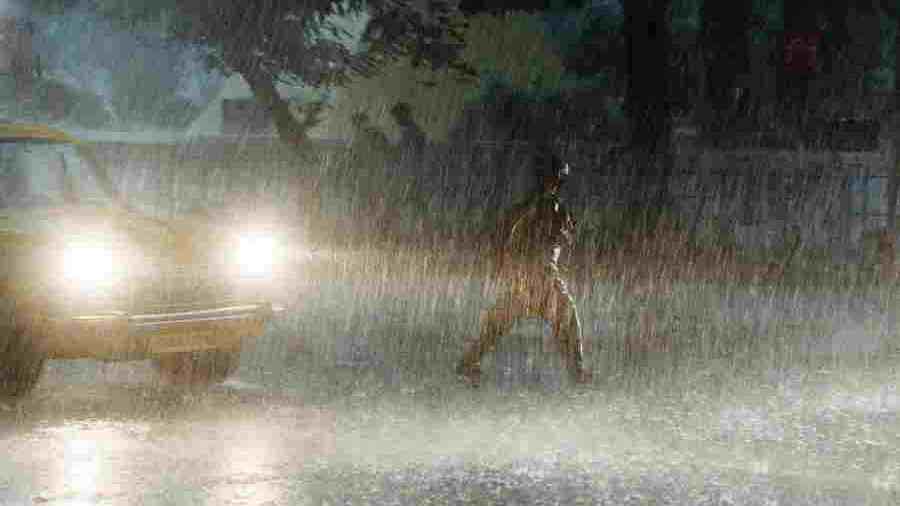A 90kmph Nor’wester tore through Calcutta late on Saturday afternoon, felling trees and lamp posts, sending billboards flying, choking traffic and disrupting Metro services.
At the Salt Lake Stadium, an AFC cup match between ATK Mohun Bagan and Bashundhara Kings was stopped for close to an hour because of the storm.
At least 36 trees were uprooted in and around Calcutta in the strongest squall of the season. In Hedua, a traffic signal fell on a moving car with three occupants, who escaped unscathed. A woman was injured after a portion of a tree fell on her on Belvedere Road.
Portions of a tree fell on the Metro tracks between Tollygunge and Kudghat, disrupting services for close to an hour from 4.40pm.
At least two Calcutta-bound flights had to be diverted and several take-offs were delayed at the city airport. “Flight services were disrupted between 4.10pm and 5.25pm. An IndiGo flight from Agartala and an Air India flight from Imphal were diverted to Bhubaneswar,” an airport official said.
The storm was accompanied by a sharp spell of rain as 12km-tall cumulonimbus clouds descended on the city.
“By the time the squall line (a mass of several clouds moving in a particular direction) reached Calcutta, it was over 250km long and 30km wide,” said G.K. Das, director of the India Meteorological Department, Calcutta.
During Cyclone Amphan, which made landfall near Sagar Island on May 20, 2020, the city was battered by winds blowing in excess of 100kmph.
A Nor’wester is a squall that originates over the heated Chhotanagpur Plateau in the late afternoon and sweeps through parts of eastern India over the next three to five hours at wind speeds of more than 45kmph. It is usually followed by a brief spell of rain.
Saturday’s storm ticked all the boxes. The morning had been hot and humid. The sky started turning grey late in the afternoon. By 3.30pm, it was fairly dark. By 4pm, the Chowringhee skyline had an ominous look. The first gusts arrived around 4.15pm. The Met office in Alipore recorded the maximum wind speed of 90kmph at 4.29pm. It began raining soon after.
“From my balcony, I saw temporary roofs made of fibreglass flying,” a Gariahat resident said. Less than 4km away, the winds shattered a windowpane at a second-floor flat near Jadavpur 8B.
In Behala, giant banners flew off the boards on Diamond Harbour Road. The rain sent visitors scurrying for cover at the Maidan. Streaks of lightning lit up the sky.
The winds abated by 5.30pm but the rain continued for at least two more hours, as a drizzle in most places.
The past two days had been humid, with the minimum relative humidity at 69 per cent on Thursday and 57 per cent on Friday. The pent-up heat and humidity led to the storm, Met officials said.
“A strong thunderstorm was due in the city. A trough of low pressure now extends from west to east, between Rajasthan and Assam. The trough passes over Jharkhand, where it is attracting moisture from the Bay,” Das said.
“The meeting of hot and dry northwesterly winds and moisture-laden southwesterly winds from the Bay led to the formation of the thunderclouds.”
As the squall line kept moving towards the coast, the clouds were strengthened by incursion of moisture from the Bay. The clouds triggered thunderstorms in the districts as they travelled.
The taller the clouds, the greater the wind speed, a weather scientist said, referring to their height of 12km.
“This is because the wind speed recorded on the ground is nothing but the ‘downdraft’ (downward current of air) inside the cloud that escapes its base and comes towards the earth,” he said.
The storm cooled the city, the Celsius dropping from 33 degrees around 3pm to 28 degrees at 5.30pm. Thunderstorms are likely over the next few days as well, Met officials said.
